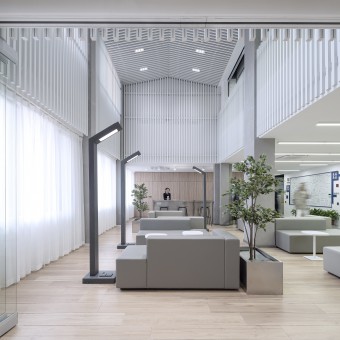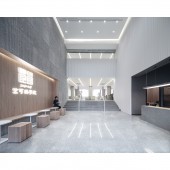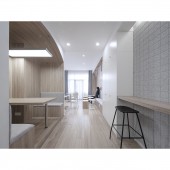Chu Kochen College Dormitory by Bennet Marburger and Ji Zhang |
Home > Winners > #119699 |
 |
|
||||
| DESIGN DETAILS | |||||
| DESIGN NAME: Chu Kochen College PRIMARY FUNCTION: Dormitory INSPIRATION: The design is functional and minimalistic with simple, yet refined forms and a restricted palette of carefully selected materials. Each space is specifically designed for its purpose and has a distinct design. However the entire project is tied together by materials, simplicity and functionality. UNIQUE PROPERTIES / PROJECT DESCRIPTION: An existing dormitory building at Zhejiang University was renovated for the Chu Kochen Honors College. Originally the building which houses approximately 1,600 students was solely designed for bedrooms. Within this project several of these rooms were transformed to create the desperately needed additional spaces for living and learning. The aim of the college was to realise a model project which can be a prototype for upcoming dormitory projects. OPERATION / FLOW / INTERACTION: BIM was used throughout the whole design process, in order to combine interior design, furniture planning and lighting design to a holistic overall planning. PROJECT DURATION AND LOCATION: The project started in August 2019 and finished in November 2020. It is located in Hangzhou, China. FITS BEST INTO CATEGORY: Interior Space and Exhibition Design |
PRODUCTION / REALIZATION TECHNOLOGY: Natural stone, wood, white metal board and plaster are used as the main materials in the public spaces. They are added by white tiles, anthracite fixtures and stainless steel according to the functional needs of the rooms. Linear lights, spots and indirect lighting create a bright and modern atmosphere. Track lighting rails allow adjustable illumination in special areas. Custom made furniture in wood, anthracite and white adds to the functional and elegant appearance of the rooms. SPECIFICATIONS / TECHNICAL PROPERTIES: The design scope covers the interior design for a total area of 2,800 m2. A wide range of rooms for collegiate everyday life was created within the existing structure of the dormitory. The design includes various spaces like lobbies, classrooms, self-study rooms, offices, exhibition spaces, recreational rooms, public kitchens and guest suites. TAGS: Interior, Renovation, Furniture, Lighting Design, Flat, Modern, Simple, Minimalistic, Functionalistic RESEARCH ABSTRACT: Our aim was to create a flexible and long-living design, that would grant the students the highest benefits possible regarding space efficiency and usability. At the same time we also had to fulfill the university’s standards concerning safety, quality and budget. The result is a very well considered spatial distribution of the functions and the use of long-lasting, resilient materials. CHALLENGE: Several rooms were combined to create larger spaces. Since the original building was exclusively designed for bedrooms, columns every 3.50 m had to be incorporated into the design. To lighten up the dark corridors formerly closed partition walls were replaced by glass walls. Folding walls and open spaces add to a higher flexibility and give the rooms a more generous atmosphere. ADDED DATE: 2021-02-23 03:30:23 TEAM MEMBERS (1) : Bennet Marburger, Ji Zhang, Chun Li, Zilin Qin IMAGE CREDITS: Image #1: Photographer Shiromio Studio, Lounge, 2021. Image #2: Photographer Shiromio Studio, Lobby, 2021. Image #3: Photographer Shiromio Studio, Salon, 2021. Image #4: Photographer Shiromio Studio, Smart Classroom, 2021. Image #5: Photographer Shiromio Studio, Guest Suite, 2021. PATENTS/COPYRIGHTS: Copyrights belong to 2408 studio for architecture, urban planning and design, 2018. |
||||
| Visit the following page to learn more: http://www.2408.studio | |||||
| AWARD DETAILS | |
 |
Chu Kochen College Dormitory by Bennet Marburger and Ji Zhang is Winner in Interior Space and Exhibition Design Category, 2020 - 2021.· Read the interview with designer Bennet Marburger and Ji Zhang for design Chu Kochen College here.· Press Members: Login or Register to request an exclusive interview with Bennet Marburger and Ji Zhang. · Click here to register inorder to view the profile and other works by Bennet Marburger and Ji Zhang. |
| SOCIAL |
| + Add to Likes / Favorites | Send to My Email | Comment | Testimonials | View Press-Release | Press Kit |
Did you like Bennet Marburger and Ji Zhang's Interior Design?
You will most likely enjoy other award winning interior design as well.
Click here to view more Award Winning Interior Design.








